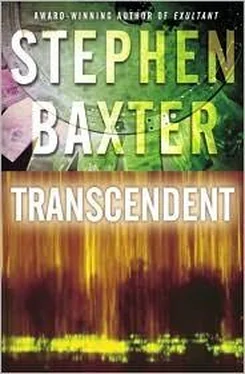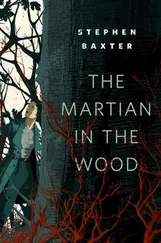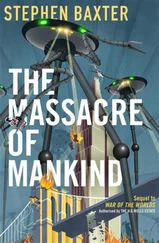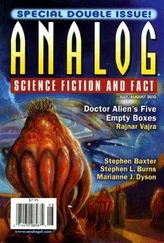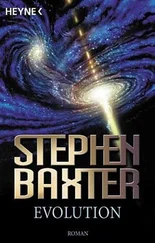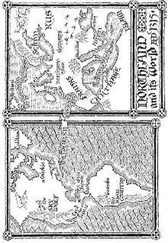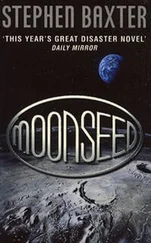John eyed me. “I’m sorry if that guy upset you.”
“He didn’t.” I found Jack Joy faintly disturbing, I guess, but I didn’t take him seriously. How wrong I was.
John was studying me. “You look like shit.”
“Oh, thanks.”
“You haven’t been sleeping.” He stepped closer to me, and said more quietly, “You’ve been seeing Morag, haven’t you?”
I glanced around, at the hovering dust drones, the crowding VR VIPs. “Keep your voice down, John. All right. Yes, I see her. I keep seeing her. It’s driving me crazy. Even if I fall asleep, I hear her voice, smell her breath, she’s there, but when I wake she’s gone, and I can’t sleep again.”
“But she isn’t speaking to you,” he said. “Not like that one time.” He stared at me intensely, hungry.
In that moment I was struck by how he had aged — the thickened neck and jaw, the burly body, the flesh of his face slowly crumpling, the marks of a man in middle age. But there was a passion in his eyes I had rarely seen before. My brother didn’t do passion. “This really matters to you, doesn’t it? The whole business with Morag. Why, John?” And I made another leap of intuition. “ Do you think you know what she’s trying to tell me? Is that it?”
I expected him to deny this, but he just stared at me, that strange, vulnerable mix of anger and longing all over his face. He said grimly, “We have to get this resolved.”
“Fine,” I said, scared, bewildered.
I think we were both relieved when we heard a soft chiming, much amplified; it was Ruud Makaay rapping a pen against an empty glass, calling us to attention.
Barnette and Makaay stood alone on a plain stage, with a view of the offshore rig framed in the big clear wall behind them.
Technicians performed last checks on the big nitrogen-liquefaction plant we’d installed on the rig. And, more importantly, we saw maps of the network of tunnels the moles had already dug out through cubic kilometers of the fragile seabed strata. Now the wall began to fill up with images from the project. We saw a mole’s eye view of a tunnel being dug into the undersea rock. “Although actually,” Shelley had pointed out to me, “since the tunnel is being constructed behind the mole as it burrows along, that’s actually a mole’s-ass view…”
Makaay said, “We call this project the Refrigerator. It isn’t a fancy name, but then I’m not a fancy guy, just an engineer who likes to get the job done — and I’ve never worked on a job of more significance than this. I’m very proud of what we’ve achieved so far, and I hope to persuade you to support us in the future, as we seek to extend our technology through all the threatened hydrate strata around both the north and south poles…”
As Makaay spoke, John and I drifted through the crowd toward the podium. Here we found Shelley, with Vander Guthrie, Tom and Sonia, other project people. There was no seating plan, no front row — in fact there were only a few seats of any kind. Ruud Makaay, an expert at crowd manipulation, didn’t like obviously stage-managed events. He believed in what he called “choreographed informality.” He was aiming for a human warmth that would belie the usual accusations of arrogance that stuck to projects like this. There would come a point when I, like the other key players on the project, would be invited to come forward to be presented to Barnette, like the winner of some VR-soap award. But, happily, I wouldn’t be called on to make any kind of speech.
“Of course we can give you any technical detail you want,” Makaay was saying. “Our analysis of the network in terms of connectivity and robustness has assured us that every functional parameter has been addressed, and all local geological conditions accommodated — and all this put together by our moles, working solo and in cooperation. Those little critters have done a good job.” Behind him a blown-up image showed a mole pushing its whirling snout up out of the ground, and it waggled this way and that, as if seeking our approval. It was a shameless bit of anthropomorphism, but it worked, and won Makaay a smattering of laughter and applause.
The crowd, evidently enjoying the show, were sympathetic for now — though whether they would be when they went back to their offices, and we started to ask for serious funding for the roll-out, was another matter. But we project types were all tense, agitated, sipping drinks and grinning nervously at each other. Even Tom grasped Sonia’s hand so hard their knuckles were white. John seemed distracted, though. I thought he looked at me as much as at the presentation. Even now, at this crucial moment, the Morag business was obviously on his mind.
To a little more applause, Makaay yielded the floor. Edith Barnette stepped forward, utterly at ease, as always wearing her years well.
“I’m not qualified to talk to you about the majestic engineering we’re here to witness today,” she said. “I’m not even qualified to talk about methane hydrate reservoirs, which are causing such concern to those who monitor our climate for us, friendly minds both human and artificial. But I can, I think, grasp the wider implications of what is happening here today. For I understand heroism.” Her voice was soft, but it carried to every corner of that big marquee, and the faces of our guests, important or self-important, intelligent or merely self-obsessed, were locked on her. “A new kind of heroism,” she said. “A heroism that seeks to save, not merely oneself, not just one’s friends or family, not even one’s nation or creed. It is a heroism that seeks to save the planet itself, and all its fragile cargo of living things. It is a heroism that seeks to save the very future…”
Standing there with the vodka coursing through my blood, her words took me back to the hopeful days when President Amin had woken us all up from our nightmare of oil dependency. Amin’s own story was a mixture of meritocracy and openness. She was the child of Iraqi refugees, and her journey, if not quite log cabin to White House, was pretty much the twenty-first century equivalent. Amin had had a simple vision, comprehensible to all, and by asserting it she managed a national, indeed global transformation.
Of course the demons fought back. Amin’s assassination had been a great punctuation mark. And then had come 2033, the Happy Anniversary flash-bombing.
It had been a HANE, as the counter-terrorists called it, a high-altitude nuclear explosion, a bomb not much bigger than the Hiroshima device, lofted a couple of hundred kilometers high aboard a small tourist spaceplane. X-rays cooked all but the most hardened low-Earth-orbit satellites, while gamma rays battered the upper atmosphere, releasing high-energy electrons that disabled any sensitive electronics in line of sight, and charged particles made the Earth’s magnetic field oscillate so that electric surges ruined cables and circuits. And a bloodred aurora had spread across the skies of a hemisphere, a sight you would never forget. The developed world was paralyzed for eight days.
It was one hell of a strike. But even now, fourteen years later, nobody knew for sure who had delivered it. An anonymous message called the “Happy Anniversary” note was sent to the FBI. It was thought perhaps it referred to the two-thousandth anniversary of Jesus’ crucifixion. Perhaps anti-Christians were responsible, then — or they may have been a Christian splinter sect — or perhaps it was just mischief-making by terrorists determined to stir up as much trouble as possible.
There were plenty of people who had problems with the Stewardship. Abroad, there were many who resented the sudden about-turn of America from the world’s worst polluter to a new conscience of the planet. And at home, many groused at our new engagement with the world: America was “a giant submitting to fleabites,” as one opponent put it. For sure there had been plenty of people who wanted to lash out in inchoate rage, at somebody or something. It could have been anybody.
Читать дальше
